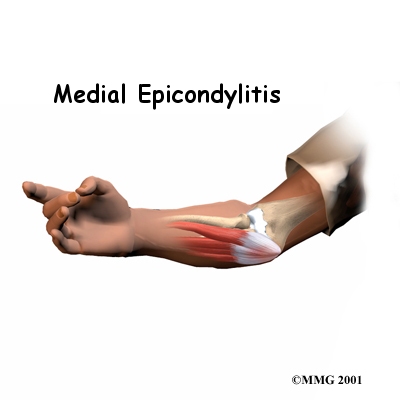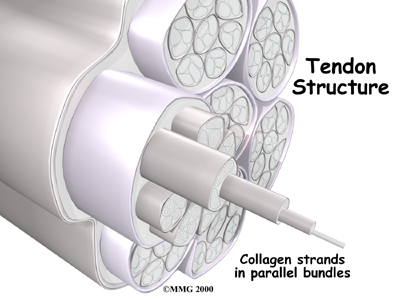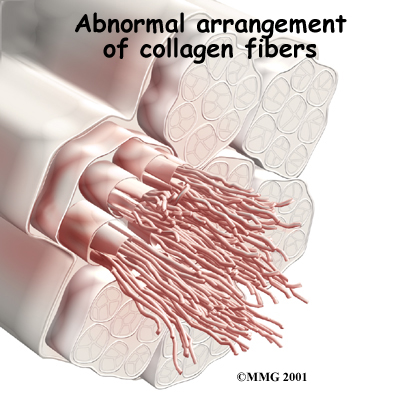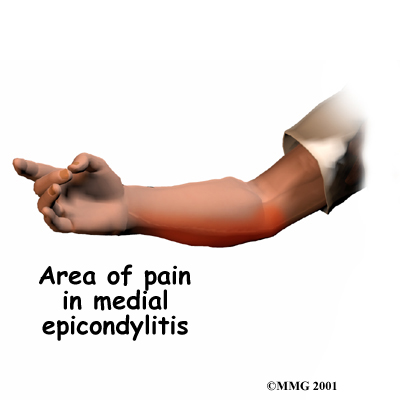Introduction
Physical therapy in Venice for Elbow

Welcome to FYZICAL Venice's patient resource about Golfers Elbow (Medial Epicondylitis).
Medial epicondylitis is commonly known as golfer's elbow. This does not mean that only golfers have this condition. But the golf swing is a common cause of medial epicondylitis. Many other repetitive activities can also lead to golfer's elbow: throwing, chopping wood with an ax, running a chain saw, and using many types of hand tools. Any activities that stress the same forearm muscles can cause symptoms of golfer's elbow.
This guide will help you understand:
- what parts of the elbow are affected
- what causes golfer's elbow
- how to make the pain go away
Anatomy
What parts of the elbow are affected?
Golfer's elbow causes pain that starts on the inside bump of the elbow, the medial epicondyle. Wrist flexors are the muscles of the forearm that pull the hand forward. The wrist flexors are on the palm side of the forearm. Most of the wrist flexors attach to one main tendon on the medial epicondyle. This tendon is called the common flexor tendon.
Medial Epicondyle

Tendons connect muscle to bone. Tendons are made up of strands of a material called collagen. The collagen strands are lined up in bundles next to each other.
Collagen

Because the collagen strands in tendons are lined up, tendons have high tensile strength. This means they can withstand high forces that pull against both ends of the tendon. When muscles work, they pull on one end of the tendon. The other end of the tendon pulls on the bone, causing the bone to move.
The wrist flexor muscles contract when you flex your wrist, twist your forearm down, or grip with your hand. The contracting muscles pull on the flexor tendon. The forces that pull on the tendon can build when you grip a golf club during a golf swing or do other similar actions.
Related Document: FYZICAL Venice's Guide to Elbow Anatomy
Causes
Why did I develop golfer's elbow?
Overuse of the muscles and tendons of the forearm and elbow are the most common reason people develop golfer's elbow. Repeating some types of activities over and over again can put too much strain on the elbow tendons. These activities are not necessarily high-level sports competition. Shoveling, gardening, and hammering nails can all cause the pain of golfer's elbow. Swimmers who try to pick up speed by powering their arm through the water can also strain the flexor tendon at the elbow.
 In some cases, the symptoms of golfer's elbow are due to inflammation. In an acute injury, the body undergoes an inflammatory response. Special inflammatory cells make their way to the injured tissues to help them heal. Conditions that involve inflammation are indicated by -itis on the end of the word. For example, inflammation in a tendon is called tendonitis. Inflammation around the medial epicondyle is called medial epicondylitis.
In some cases, the symptoms of golfer's elbow are due to inflammation. In an acute injury, the body undergoes an inflammatory response. Special inflammatory cells make their way to the injured tissues to help them heal. Conditions that involve inflammation are indicated by -itis on the end of the word. For example, inflammation in a tendon is called tendonitis. Inflammation around the medial epicondyle is called medial epicondylitis.
However, golfer's elbow often is not caused by inflammation. Rather, it is a problem within the cells of the tendon. Doctors call this condition tendonosis. In tendonosis, wear and tear is thought to lead to tissue degeneration. A degenerated tendon usually has an abnormal arrangement of collagen fibers.
Instead of inflammatory cells, the body produces a type of cells called fibroblasts. When this happens, the collagen loses its strength. It becomes fragile and can break or be easily injured. Each time the collagen breaks down, the body responds by forming scar tissue in the tendon. Eventually, the tendon becomes thickened from extra scar tissue.
No one really knows exactly what causes tendonosis. Some doctors think that the forearm tendon develops small tears with too much activity. The tears try to heal, but constant strain and overuse keep re-injuring the tendon. After a while, the tendons stop trying to heal. The scar tissue never has a chance to fully heal, leaving the injured areas weakened and painful.
Scar Tissue

Symptoms
What does golfer's elbow feel like?
The main symptom of golfer's elbow is tenderness and pain at the medial epicondyle of the elbow. Pain usually starts at the medial epicondyle and may spread down the forearm. Bending your wrist, twisting your forearm down, or grasping objects can make the pain worse. You may feel less strength when grasping items or squeezing your hand into a fist.

Diagnosis
How can I be sure I have golfer's elbow?
When you first visit FYZICAL Venice, our physical therapist will take a detailed medical history. You will need to answer questions about your pain, how your pain affects you, your regular activities, and past injuries to your elbow.
The physical exam is often most helpful in diagnosing golfer's elbow. Our physical therapist may position your wrist and arm so you feel a stretch on the forearm muscles and tendons. This is usually painful with golfer's elbow. We may also use other tests of wrist and forearm strength to help diagnose golfer's elbow.
Golfer's elbow symptoms are very similar to a condition called cubital tunnel syndrome. This condition is caused by a pinched ulnar nerve as it crosses the elbow on its way to the hand. If your pain does not respond to treatments for golfer's elbow, our therapist may suggest tests to rule out problems with the ulnar nerve.
Related Document: FYZICAL Venice's Guide to Cubital Tunnel Syndrome
Some patients may be referred to a doctor for further diagnosis. Once your diagnostic examination is complete, the physical therapists at FYZICAL Venice have treatment options that will help speed your recovery, so that you can more quickly return to your active lifestyle.
FYZICAL Venice provides physical therapist services in Venice.
Our Treatment
Non-surgical Rehabilitation
The key to nonsurgical treatment is to keep the collagen in your tendon from breaking down further. Our goal is to help the tendon heal.
When you begin your physical therapy program at FYZICAL Venice, our physical therapist will give you tips on how to rest your elbow and how to do your activities without putting extra strain on your elbow. We may apply tape to take some of the load off the elbow muscles and tendons. Our physical therapist may advise the use of an elbow strap that wraps around the upper forearm in a way that relieves the pressure on the tendon attachment.
Your physical therapist in Venice may apply ice and electrical stimulation to ease pain and improve healing of the collagen. Our physical therapy sessions may also include iontophoresis, which uses a mild electrical current to push anti-inflammatory medicine, prescribed by your doctor, into the sore area. This treatment is especially helpful for patients who can't tolerate injections. Exercises are used to gradually stretch and strengthen the forearm muscles.
Because tendonosis is often linked to overuse, our therapist will work with you to reduce repeated strains during activity. When symptoms are from a particular sport or work activity, we will observe your style and motion with the activity. Our physical therapist may suggest ways to protect the elbow during your activities. We can also check your sports equipment and work tools and recommend ways to alter them to keep your elbow safe.
Although the time required for rehabilitation is different for each patient, in cases where the tendon is inflamed, nonsurgical treatment is usually only needed for four to six weeks. When symptoms are from tendonosis, you can expect healing to take longer, usually up to three months. If the tendonosis is chronic and severe, complete healing can take up to six months.
Post-surgical Rehabilitation
Recovery from surgery takes longer. Immediately after surgery, your elbow is placed in a removable splint that keeps your elbow bent at a 90-degree angle.
When you begin your physical therapy program, ice and electrical stimulation treatments may be used during your first few therapy sessions to help control pain and swelling from the surgery. Our physical therapist may also use massage and other types of hands-on treatments to ease muscle spasm and pain.
We will gradually have you work into more active stretching and strengthening exercises. You just need to be careful to avoid doing too much, too quickly. We typically begin patients on active therapy about two weeks after surgery. Our physical therapist may begin with light isometric strengthening exercises. These exercises work the muscles of the forearm without straining the healing tissues. You will also begin to use your own muscle power in active range-of-motion exercises.
At about six weeks, our physical therapist may have you start doing more active strengthening. As you progress, we will give you exercises to help strengthen and stabilize the muscles and joints of the wrist, elbow, and shoulder. You'll also do exercises to improve fine motor control and dexterity of the hand. Some of the exercises you'll do are designed to work your hand and elbow in ways that are similar to your work tasks and sport activities. Our physical therapist will help you find ways to do your tasks that don't put too much stress on your elbow.
Although the amount of time required for recovery varies among patients, you may need physical therapy for two to three months. It may take four to six months to get back to high-level sports and work activities. Before your physical therapy sessions end, our physical therapist will teach you a number of ways to avoid future problems.
FYZICAL Venice provides services for physical therapy in Venice.